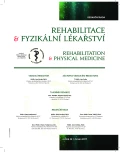Influencing Brain Vascular event by Proprioceptive Neuromuscular Facilitation on Stroke Disease
Authors:
E. Musilová
Authors‘ workplace:
Katedra športovej kinantropológie, Fakulta telesnej výchovy a športu, Univerzita Komenského v Bratislave
Published in:
Rehabil. fyz. Lék., 24, 2017, No. 2, pp. 100-103.
Category:
Original Papers
Overview
Stroke is the most common cause of death in developed countries right after cardiovascular and cancer diseases. Number of patients may be higher from year to year with increasing age, but in last years this disease has upward trend and more affects on younger generation. The aim of this article is to point out the importance of early realization of facilitation techniques and methods for improving self-sufficient and independence from other person and comparison of two methods.
10 patients, all diagnosed with stroke, took part in the survey. Mean age of all of them was 71 years. Patients were divided into two groups, 5 patients each. Within the kinesiotherapy, during 8 weeks, we used on every working day Bobath concept with one group and Kabat method with the other. Before the kinesiotherapy program had began, every patient took entrance FIM examination and at the end, after 8 weeks, final FIM examination, so we could review differences.
Our results show, that both methods, Bobath concept and Kabat method, have positive effects, if they are realized right after stroke disease is diagnosed. All patients, after only 8 weeks, had better functional independence, mainly in moving, personal care and self-sufficiency.
Keywords:
facilitation methods, self-sufficiency, FIM examination
Sources
1. BARTOLČIČOVÁ, B.: Uplatnenie masáže v športovom tréningu. Rehabilitácia 3, Bratislava: Liečreh, 2015. 177 s., ISSN 0375-0922.
2. BRAININ, M., HEISS, W. D.: Textbook of stroke medicine. Cambridge, Cambridge University Press, 2010. ISBN 978-0-521-51826-0.
3. GÚTH, A.: Liečebné metodiky v rehabilitácii, Prvé vydanie. Bratislava, Liečreh, 2011. 206 s., ISBN 80-88932-16-5.
4. HORÁČEK, O., KOLÁŘ, P.: Cévní onemocnění mozku. In KOLÁŘ P. a kol. 2009. Rehabilitace v klinické praxi. 1. vyd., Praha, Galén, 2009. s. 386 393. ISBN 978-80-7262-657-1.
5. KOLÁŘ, P.: Rehabilitace v klinické praxi, První vydání. Praha, Galén, 2010, 390 s., ISBN 978-80-7262-657-1.
6. KOTTKOVÁ, K.: Fyzioterapia u pacientov po cievnej mozgovej príhode: ischemické vs. hemoragické CMP. Diplomová práca. Bratislava, SZU, 2013, s. 67.
7. LIPPERTOVÁ-GRÜNEROVÁ, M.: Neurorehabilitace. První vydání. Praha, Galén, 2005, s. 78-82, s. 102-103, s. 107-109, s. 280. ISBN 80-7262-317-6.
8. MAČKINOVÁ, M., TUMA, J., MASARYK, V., MATYŠÁK, P.: Globalizačný vplyv na jedinca a jeho fungovanie v spoločnosti. Eniologie člověka: vědecko-odborný časopis nejen pro vědu a odbornost, ale i pro každého, kdo se chce dozvědet více, roč. 6, 2015, č. 5, s. 11-14. ISSN 2336-4157.
9. MUMENTHALER, M., MATTLE, H.: Neurologie. První vydání. Praha, Grada Publishing, 2001, s. 75-76, s. 98., s. 163, s.169, s. 184. ISBN 80-7169-545-9.
10. NEVOLNÁ, T., MALAY, M.: Zdravotné plávanie a pohybová liečba vo vodnom prostredí. 1. vydanie. Univerzita Tomáše Bati ve Zlíne, 2015, s .120, s. 159. ISBN 978-80-7454-514-6.
11. PAVLŮ, D.: Speciální fyzioterapeutické koncepty a metody: Koncepty a metody spočívajíci převažně na neurofyziologické bázi. 2 vydání. Brno, Akademické nakladatelství CERM, 2003. s. 239. ISBN 80-7204-312-9.
12. PFEIFFER, J.: Neurologie v rehabilitaci: Pro studium a praxi. První vydání. Praha, Grada Publishing, 2007, s. 145-150, s. 153-154. ISBN 978-80-247-1135-5.
13. VAŇÁSKOVÁ E., TOŠNEROVÁ V., BUKAČ J.: Hodnocení nemocných po cévní mozkové příhodě testy soběstačnosti na lůžkovém rehabilitačním pracovišti. Rehabilitace a fyzikální lékařství, 2003, č. 2, s. 60-64.
Náhradné ospravedlnenie za nezacitovanie Mgr. Kataríny Kottkovej v publikovanom článku Eva Musilová, Elena Žiaková , Daniela Letašiová: Fyzioterapie u pacientů po cévní mozkové příhodě. In Rehabil. fyz. lék., roč. 21, 2014, č. 3, s. 136-140. ISSN 1211-2658
Labels
Physiotherapist, university degree Rehabilitation Sports medicineArticle was published in
Rehabilitation & Physical Medicine

2017 Issue 2
Most read in this issue
- Carpal Instability
- Influencing Brain Vascular event by Proprioceptive Neuromuscular Facilitation on Stroke Disease
- Comparison of Selected Methods for Strengthening Stabilization Muscles of Lumbar Spine in Vertebrogenic Patients
- Analgesic Effect of Hyperbaric Oxygen Therapy
